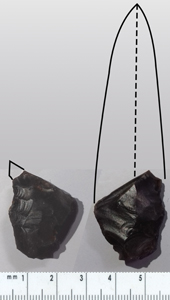Multi-purpose flint (Neolithic)

Click ^ for larger image.
A prehistoric flint tool found in December 2021 in a field at the proposed housing development at Brislington Meadows shows that once it was no longer fit for its primary purpose, it was changed into an entirely different type of tool - not once, but twice. The Stone Age was not a throw-away culture.
Around 5,000 years ago, a local resident struck a precise blow on a large chunk of flint, and a sliver of black stone split away from the core. Around 10cm in length, 2 wide, and just 0.5 thick, this was a double-edged knife blade as sharp as a modern razor.
Flint doesn't occur naturally in this area - and this quality comes from a chalk geology (probably Salisbury Plain), so they'd had to barter something valuable to get hold of the nodule of rock. Kurt Adams, Finds Liaison Officer (Portable Antiquities Scheme, Bristol Museum & Art Gallery), estimated its age to around 3,500 BCE to 2,500 - the later part of the New Stone Age (Neolithic).
It takes concentration to knap flint successfully, so while they were in the mood, they'd probably have struck several more at least, putting the blades carefully aside for later use. These were everyday items, but black flint like this is high quality and wasn't cheap, so when eventually this one broke, it wasn't thrown away but examined to see how it could best be re-used (lower grade grey flint was often so riddled with flaws that options for re-use were limited).
The back of the blade is smooth and gently curved, while the front has a distinctive central ridge that runs the full length down to the pointed tip - this ridge gives the stone some much needed strength, as thin flint is brittle as glass. The shape is useful in another important way - when the blade happens to break diagonally across the width, as this one did (about 3cms from the base), each of the sharp edges ends in a point - one on each part of the broken tool.
From one tool, two more emerge - not cutting edges, but sharp points that can pierce animal skins for sewing clothes, like an awl. When held, the thumb firmly presses into the smooth back while the fore- and middle-fingers rest either side of the central ridge - it's the familiar grip we use when we hold a pen.
The identification of this awl as part of a sewing kit is bolstered by another feature that's characteristic of this sort of tool. Just up from its point, the sharp edge is flaked with tiny notches that nibble into the stone forming a concave crescent of serrations. Sewing thread or even sinew rasped sharply against this miniature saw-toothed sickle could be severed as readily as cutting it with a pair of scissors.
Eventually the tip of the awl broke, but even then this veteran tool saw further use. The original break across the blade was sharp enough to use as a flat-edged scraper and it has tell-tale signs of wear. To grip it tightly the middle finger curls against the back, the thumb rests against the ridge, and the forefinger needs to press down right on the original edge of the blade (the section just above the crescent cutter was carefully blunted for comfort).
Every last part of this little stone was used intensively - whatever they'd paid the merchant who'd brought the original nodule, they clearly got their money's worth. Even after three uses, it's likely the remnant was put aside in case hard times one day brought it back into play (happily for our farming family, it appears that day never came).
Flint blades like this were literally cutting-edge technology in the Neolithic (New Stone) Age, and the people that used them were among the first to live in one place and farm the land (their predecessors had favoured a more nomadic lifestyle). Such relics of these earliest settled inhabitants of Brislington are not uncommon, which suggests the community here was thriving and it's likely that Brislington has been populated continuously ever since.
It's poetically apt that this tool made by a farmer was found in a spot that's still an open field. It's extremely unlikely that its sibling, the other piece of the broken blade, will ever be found, but such things can happen - it would be fascinating to know just how it too was refashioned into an item that was still useful (probably also more than once).
Our Stone Age flint knapper knew that each of the blades - chips off the old block - would go through its own sequence of changes before being laid to rest. As day follows night, it's part of the natural cycle to find and creatively resurrect the value in something broken. It took our craftsperson a good deal of time and practise to master each of the techniques required to produce an array of different tools, and this single relic is a powerful testament to this unknown Brisling's imagination, ingenuity and skill.
Before meeting with Kurt Adams, this flint featured on page 6 of the Bristol Times insert in the Bristol Post on 04-01-2022.
Material: stone
Period: Stone Age
Find spot: ST62607102, Brislington Meadows.
Exhibit contributed by Ken Taylor
Text written by Ken Taylor
Photographer: Ken Taylor
Acquisition number: 220212a1